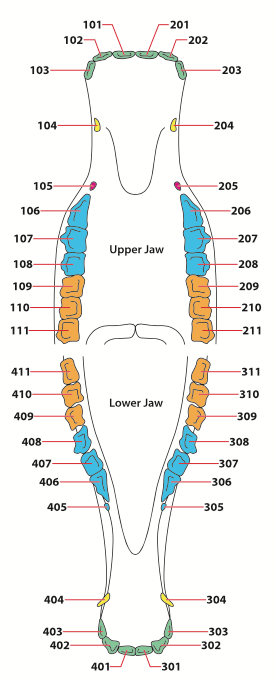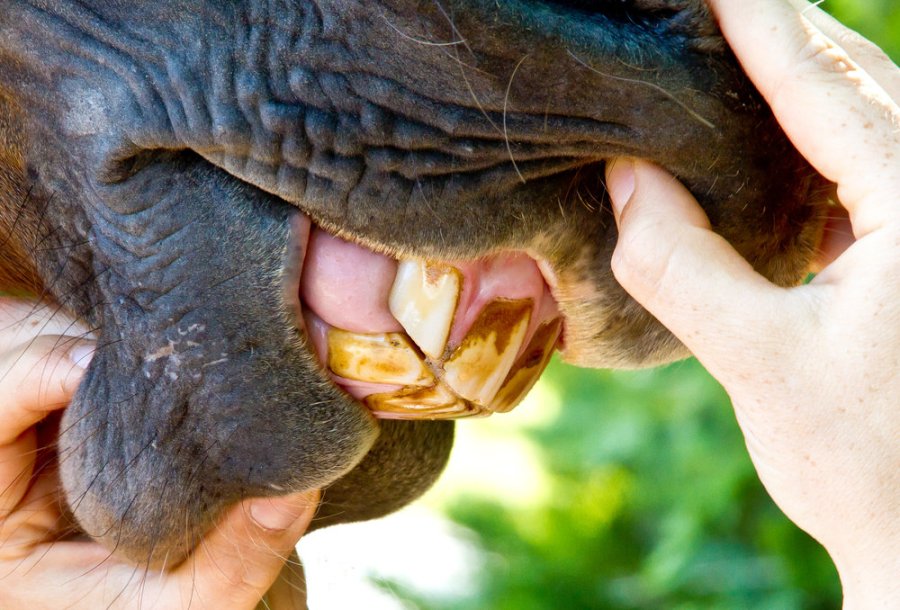It is possible to age a horse by looking at their teeth — you just need to know how to do it and what you’re looking for.
Bear in mind, however, that a horse’s teeth only provide an estimation of their age and it is not a fool proof process. General wear on teeth is affected by so many different factors, not least correct routine dental care.
“Ageing a horse is relatively simple, but there are some exceptions, especially in horses that crib bite or windsuck,” explains James Sheppard, an equine dental technician with 17 years’ experience who has treated equines in 18 different countries, including top-level performance horses.
“The natural shedding of the deciduous (baby) teeth of a young horse is generally very accurate, so up to the age of five you can be fairly precise.”
A very young horse’s age is worked out according to what teeth they still have in their mouth and which they have lost. After that, how to age a horse by their teeth is more of an estimation because it is affected by wear on the teeth.
Number of teeth
 Most young horses have 24 deciduous (baby) teeth. By the time they reach maturity, a stallion or gelding will have between 40 and 44 teeth, while a mare has around 36 to 40 teeth.
Most young horses have 24 deciduous (baby) teeth. By the time they reach maturity, a stallion or gelding will have between 40 and 44 teeth, while a mare has around 36 to 40 teeth.
Mares have slightly fewer, because they don’t usually have canine teeth.
You will often hear a vet or equine dental technician refer to your horse’s teeth by numbers.
Each tooth has its own number, according to where it is located in the mouth. This makes it easier to record any problem teeth and general updates after a horse has had their routine teeth check.
The diagram shows which number teeth are where:
- Green = incisors (these are the horse teeth you can easily see at the front of the mouth)
- Yellow = canine teeth (as mentioned above, not all horses have these)
- Pink = wolf teeth (these teeth can sometimes interfere with the bit and cause horses pain, and so are removed)
- Blue = premolars
- Orange = molars (teeth at the back of the horse’s mouth)
Teeth numbered with a 1 at the start (eg 101) are in the top of the horse’s mouth, on the right side.
The teeth starting with a 2 are also at the top of the mouth, but on the left side.
In the lower jaw, teeth 301-311 are on the left side, while horse teeth 401-411 are on the lower right side.
What is the Galvayne’s groove?
When considering how to age a horse, the Galvayne’s groove is a key to working out the answer.
The Galvayne’s groove starts to appear on a horse’s teeth at the age of 10 and can be seen until the horse is between 25 and 30 years old. This is how to age a horse from their 10th year up to around the time they turn 30, although as already mentioned it provides an estimation only.
“The Galvayne’s groove is a brown mark that appears at the gum line at the centre of the upper corner incisor,” explains James Sheppard.
“This mark grows down and reaches halfway down the tooth by the time the horse or pony is 15 years old, before leaving the gum line altogether at 20 years old.
“The Galvayne’s groove grows out completely during the five to 10 years afterwards, and this is how to age a horse who is between 25 and 30 years old.”
Teeth characteristics of a five to 10-year-old
Like humans, horses get two sets of teeth in their lifetime. Most horses have 24 deciduous (baby) teeth and they appear early — usually within the first two weeks after being born.
Mature stallions have between 40 and 44 teeth, while mature mares have around 36 to 40 teeth.
The difference is due to the fact that the canine teeth, which should appear when the horse is around four to five years of age, are often not seen in mares.
People often get the canine teeth confused with wolf teeth, but they’re not the same thing. The canines are bigger and sit in front of the wolf teeth (which not all horses get), while the wolf teeth erupt through the gums earlier than the canines.
James explains that between the ages of five and 10, there are certain characteristics to note about a horse or pony’s teeth:
- The upper corner incisors begin coming into wear, and a small ‘beak’ appears on that same incisor at age seven.
- Large cusps (raised areas) on the occlusal (chewing) surfaces of the incisors decrease in size as the horse gets older.
“The older the horse, the more acute the angle where the incisors meet, and the more triangular the incisors appear to be,” says James.
How to age a young horse
Unlike human teeth, which fully erupt prior to maturity, a horse’s teeth will erupt throughout their life. This is why teeth play such an influential role in answering the question of how to age a horse, because they are constantly changing.
“Horses will lose 24 caps (baby teeth) and have a complete set of permanent teeth before they are six years old, so there is a lot of activity at a time when a horse is having a bit introduced,” explains Dr Melissa Emson, an equine vet and dentist who runs The Equine Dental Vet.
“Soft, fast erupting permanent teeth can cause trauma to the soft tissue of the mouth, as can the sharp edges of loose caps, and they are the most common find when examining the mouths of young, recently-backed horses and ponies.”
Teeth in an older horse
How to age a horse who is in their later years mostly comes down to wear on the teeth, but there are some common behavioural signs that teeth belong to older horses to watch for as well.
“The most common issues I hear from the owners of geriatric horses are weight loss, diarrhoea, struggling to eat hay, a reduced appetite, or becoming a fussy feeder,” says Melissa.
“If your horse prefers a softer meadow hay rather than a course hay, it could be that they’re struggling to chew it. The grinding surface of geriatric teeth are smoother than the abrasive surface of a younger horse’s tooth, hence older horses find it harder to grind more coarse food.”
Older and more worn teeth are also narrower and therefore hay and chaff often become lodged between teeth, which can result in painful gum disease that prevents the chewing of food into smaller particles.
“Signs of this include weight loss, diarrhoea, the dunking of hay in water buckets, food packing in the cheek, a foul smell from the mouth, slow eating and quidding balls where food isn’t able to be swallowed because it isn’t chewed sufficiently well,” adds Melissa.
“Some younger horses can also have gaps — known as diastemas — due to displaced cheek teeth, or where the teeth have failed to migrate together.”
Find an equine dental technician
The British Association Of Equine Dental Technicians (BAEDT) was founded in 2001 and is an organisation for qualified professional equine dental technicians. Make sure it is a vet or an equine dental technician registered with BAEDT treating your horse. A full list of fully qualified BAEDT Equine Dental Technicians can be found here.
Main image: copyright Shutterstock. Diagram: copyright Your Horse Library/Kelsey Media Ltd









